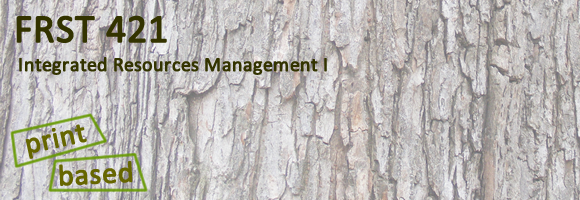
Mode of Delivery
This is a print-based, correspondence course.
Course Outline
- Six assignments
- Lab session
- Final exam
Course Description
Student Profile
Tristan Banwell, UBC Forestry Graduate

“This is a great subject for me, as I have an interdisciplinary resource management background, but I do not know much about modelling, linear programming, decision analysis and simulation as planning and management tools.”
FRST 421 Integrated Resources Management I – Introduction to the quantitative tools necessary in forest management.
Pre-requisite
Forestry 238 and 332. Because it is unlikely that many individuals interested in taking the distance version of this course will have access to a course similar to FRST 332 (Introduction to Applied Mathematical Programming for Forestry), the prerequisite material from that course is included as part of this course. The other pre- and co-requisites remain the same as for the on-campus version of the course.
Intended Student
This course is intended primarily for individuals interested in becoming professional foresters within British Columbia. Many of these individuals will be registered with the Association of British Columbia Professional Foresters (ABCPF) as either Foresters in Training (FITs) or Pupils. This course is designed to meet the criteria developed by the ABCPF for one of the core subject areas identified by the ABCPF as being necessary for all prospective foresters within British Columbia.
Although this course may be of interest to members of the general public, it is designed for individuals who have previously acquired a solid academic background in forestry.
Course Objectives
Upon successful completion of the course, you will:
- have developed an overall context for forest management and an appreciation of the complexities that exist when you are designing and developing a management plan for a forest;
- know how to apply several useful management tools (such as decision analysis, linear programming, simulation) in a forest management context; and
- have aquired an understanding of several planning concepts and techniques and have some knowledge of how they are used, or could be used, in forest management in British Columbia.
Course Content
The content is discussed in six lessons:
- Lesson 1: Introduction to Forest Management — What is forestry?; What is forest management?; Key components of forest management.
- Lesson 2: Introduction to Decision Analysis — Context for decision making; Analyzing decisions using a decision tree.
- Lesson 3: Historical Perspective on Forest and Stand Dynamics — Even-aged timber management; uneven-aged timber management; Modelling stand dynamics.
- Lesson 4: Introduction to Linear Programming and Simulation — Linear programming; Simulation.
- Lesson 5: Modelling Forerst Dynamics — Linear programming approaches; Simulation approaches; Spatial modelling approaches.
- Lesson 6: Forest Management Planning Concepts — Overview of planning theory and principles; Forest planning in British Columbia; Final comments
Evaluation
The grade for the course work will be broken down into the following percentages:
| Six Assignments | 30% |
| Final Laboratory Report | 20% |
| Final Examination | 50% |
| Total | 100% |
In order to pass the course, students must:
- complete and submit all assignments before writing the final examination;
- obtain a passing mark (>50%) on the examination; and
- obtain an overall passing mark in the course.
Textbooks and Course Materials
- FRST 421 CCM: Reprint of Brown, D.W. 1996. Strategic Land Use Planning Source Book.
- Davis, L.S. & K.N. Johnson, P. Bettinger, T.E. Howard. 2005. Forest Management: To Sustain Ecological, Economic and Social Values. 4th ed. Waveland Press. ISBN: 9781577664369
- FRST 421 Learner Package (includes course manual)
